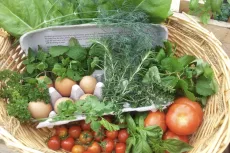
Climate change is not just a trendy phrase anymore, it is a reality. Science is documenting and demonstrating the effects of industrialization on our planet. However, it is not just the planet that is suffering from poor production practices, it is the collective human health. It is becoming disturbingly clear for anyone who is paying attention that the way human beings eat determines how the planet and its various ecosystems are being treated. From overfishing in the Mediterranean Sea, to soil pollution from livestock, or the astounding amount of plastic waste in the oceans, human beings have and are making a mess.
Fortunately, enough people have become aware of the environmental issues as well as the current and forecasted negative effects upon the human race that news is spreading and people are waking up. Usually, though, people tend to respond more favorably to change when the effects are a direct threat to their own well being. It is harder to ignore an issue when it starts to directly affect one's daily health.
What’s great, surprisingly, is that the two issues are linked. This way, choosing to eat healthier, and more sustainably actually benefits the environment as well! With these things in mind, here are some ways in which sustainable eating practices can help the environment by reducing your carbon footprint, but first, let’s cover what sustainable eating actually means and looks like.
Sustainable Eating
Traditionally an agricultural term, the concept of sustainability is typically used in reference to the production of plant and animal food sources. The goal is using farming techniques to help protect and conserve natural resources. Interestingly, sustainable agriculture also affects the quality of food produced and consumed thus benefiting the whole, thus sustainable eating is intrinsically linked to sustainable food production practices.
Sustainable eating is the consistent action of choosing foods that are healthy for our bodies and planet. A quick example of this is by disciplining oneself to include more plant-based materials into a diet which consists more of things like whole grains, fruits, vegetables, legumes (beans, peas, lentils etc.) and nuts rather than animal-based foods like red meat. Here are some steps for sustainable eating.
Healthy Steps— For You and the Planet
Growing Your Own Food
Most people like plants, if not taking care of them (which can be tricky) then at least being around them. Growing your own food encourages you to become aware of not only how different foods grow, but what is required in their growth and maintenance. Industrial agriculture cuts a lot of corners in order to produce more food.
Pesticides that are harmful for us to ingest and end up poisoning the soil are just one of the many ways irresponsible human practices are affecting our lives. By growing your own food not only are you cutting down (however fractionally) the demand for the use of those industrial practices, but you can also be more confident that the food going into your body is actually safe and nutritious.
Shopping Locally
Most people enjoy farmers markets. They have the added rewards of being a way to support local commerce, eat healthier, and help reduce your carbon footprint. Buying locally greatly reduces the processes of transporting foods. Rather than buying lettuce grown in Mexico requiring hundreds of pounds of fuel to be transported, U.S food grown by a local farmer can bring it to your neighborhood from 10 miles away.
Eat More Plant Foods
Choosing to eat two plant-based meals per day can cut your carbon footprint emissions by 50%! It typically requires 100x more water to produce one pound of animal protein. Plants require a fraction of that.
Eat Seasonally
All foods have a growing season, which means that they don't’ grow in certain hemispheres depending on the time of year, yet in our modern economy we somehow still have the option to buy foods out of season. How is this? This availability means that products are being grown in other countries or continents. Again, that requires a lot of fossil fuels.
Those are just a few of the ways to help yourself and the environment.






















